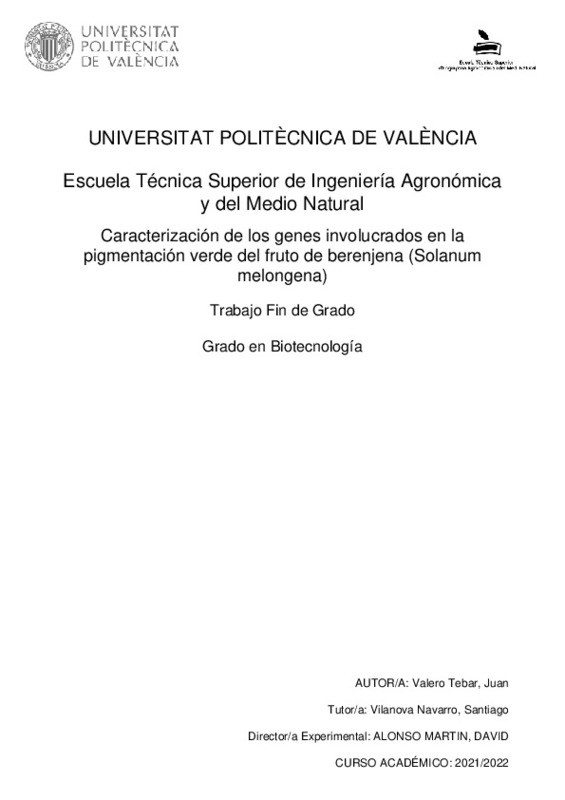|
Resumen:
|
[ES] La berenjena (Solanum melongena) es un cultivo perteneciente al género Solanum de gran relevancia en todo el mundo. Sin embargo, la mayor parte de investigación se realiza en otros cultivos modelo del género como el ...[+]
[ES] La berenjena (Solanum melongena) es un cultivo perteneciente al género Solanum de gran relevancia en todo el mundo. Sin embargo, la mayor parte de investigación se realiza en otros cultivos modelo del género como el tomate o la patata, siendo necesario una mayor investigación en este cultivo. Uno de los aspectos que requiere una mayor investigación es la pigmentación del fruto.
Tras el análisis GWAS sobre una población MAGIC realizado por el COMAV, se identificaron dos genes candidatos para la síntesis de clorofila: el gen APRR2 situado en el cromosoma 8 y el gen GLK2 situado en el cromosoma 4. El estudio reveló dos variantes en el gen APRR2 causantes de la ausencia de pigmentación por clorofila, también se detectó la presencia de una deleción en el genoma que también provocaba la ausencia de pigmentación. Del gen GLK2 no se detectó ninguna variante de gran impacto que provocará la presencia de netting.
El proyectó tiene como objetivo la validación de la existencia de la deleción en el gen APRR2 y la búsqueda de variantes en el gen GLK2 que provoquen la diferencia de expresión. Para el estudio del gen APRR2 se emplearon las variedades 67/3, que presenta la deleción e IVIA y A0416 que presentan un SNP que provoca la ausencia de pigmentación. Tras realizar amplificaciones del gen se comprobó que la variedad 67/3 presenta una deleción en el gen APRR2, este resultado fue comprobado mediante la amplificación de muestras de la colección nuclear de berenjena establecida bajo el marco del proyecto europeo G2P-SOL. Para el estudio del gen GLK2, se realizó el procesado de la resecuenciación de los parentales de poblaciones ILs (MEL1, MEL3, MEL5, INS1, DAS y ELE), no se detectó ninguna variante de gran impacto en el gen, pero sí se observó la presencia de una inserción en la región 5¿UTR en las variedades con netting. Tras realizar amplificaciones de esta región, se vio su presencia en dos de los parentales con netting (DAS y ELE), mientras que los otros parentales con netting (MEL3 y INS1) presentaban una deleción contrariamente a lo esperado, siendo necesario más investigación en esta región genómica. También se comprobó si existía diferencia de expresión del gen entre los parentales amplificando el cDNA, dando como resultado que los parentales con netting, presentaban una expresión ligeramente superior a los parentales que no poseían netting. Sin embargo, todavía es necesario la optimización de protocolos para poder observar esta diferencia de expresión con más claridad
[-]
[EN] The aubergine (Solanum melongena) is a crop belonging to the Solanum genus of great relevance throughout the world. However, most of the research is carried out on other model crops of the genus such as tomato or ...[+]
[EN] The aubergine (Solanum melongena) is a crop belonging to the Solanum genus of great relevance throughout the world. However, most of the research is carried out on other model crops of the genus such as tomato or potato, and further research on this crop is necessary. One of the aspects that requires further investigation is the pigmentation of the fruit.
After GWAS analysis on a MAGIC population carried out by COMAV, two candidate genes for chlorophyll synthesis were identified: the APRR2 gene located on chromosome 8 and the GLK2 gene located on chromosome 4. The study revealed two variants in the APRR2 gene causing the absence of pigmentation by chlorophyll, the presence of a deletion in the genome that also caused the absence of pigmentation was also detected. On the GLK2 gene, no high-impact variants were detected that would cause the presence of netting.
The project aims to validate the existence of the deletion in the APRR2 gene and search for variants in the GLK2 gene that cause the difference in expression. For the study of the APRR2 gene, varieties 67/3 were used, which presents the deletion, also IVIA and A0416, which present a SNP that causes the absence of pigmentation. After performing gene amplifications, it was found that the 67/3 variety has a deletion in the APRR2 gene. This result was verified by amplifying samples from the nuclear collection of aubergines established under the framework of the European project G2P-SOL. For the study of the GLK2 gene, the processing of the resequencing of the parental ILs populations (MEL1, MEL3, MEL5, INS1, DAS and ELE) was carried out, no variant of great impact was detected in the gene, but it was observed the presence of an insertion in the 5'UTR region in the netted varieties. After carrying out amplifications of this region, its presence was seen in two of the netted parents (DAS and ELE), while the other netted parents (MEL3 and INS1) presented a deletion contrary to expectations, requiring more research in this area. genomic region. It was also checked if there was a difference in gene expression between the parents by amplifying the cDNA, resulting in the parents with netting having a slightly higher expression than the parents who did not have netting. However, protocol optimization is still necessary to be able to observe this difference in expression more clearly.
[-]
|







